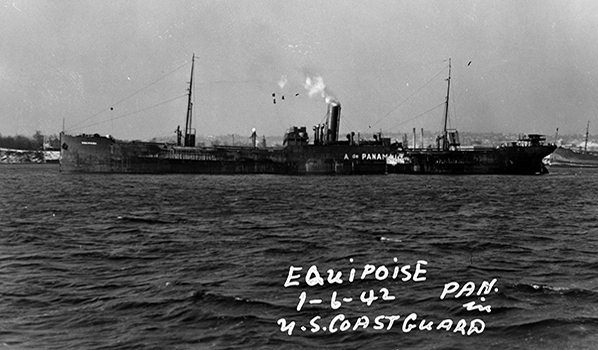Equipoise

Ship Stats
Location: Last known location 36°36'0"N, 74°45'0"W (36.60000, -74.75000)
Depth: 140 feet
Vessel Type: Freighter
Length: 430.2 feet Breadth: 54.3 feet
Gross Tonnage: 6,210 Cargo: 8,000 tons of manganese ore
Built: 1906, Barclay, Curle and Co., Glasgow, United Kingdom
Hull Number: Unknown Port of Registry: Panama/Panama
Owner: United States Maritime Commission
Lloyd's Register Details: Steel hull, two decks, deep framing, DR triple expansion, three cylinder engine
Former Names: Chanda (British India Steam Co.: 1906-1925); Pietro Campanella (Tito Campanella: 1925-1941)
Date Lost: March 27, 1942
Sunk By: U-160 Survivors: 13 of 54 survived (41 dead)
Data Collected on Site: NOAA has collected historical data on the Equipoise, but has not physically visited the shipwreck site.
Significance: Casualty of World War II's Battle of the Atlantic
Wreck Site
Through historical research and condition reports from the recreational diving community, NOAA believes the shipwreck at this location is Equipoise. The wreck site is located in about 140 feet of water, 65 miles southeast of Cape Henry, Virginia. The wreck is contiguous with the cabin being the highest relief point at the stern. The engine, two boilers, and the condenser are also exposed.
Historical Background

Originally named Chanda, the freighter operated from 1906 through 1925 for the British India Steam Navigation Company. It was sold to the Italian Navigation Company and renamed Pietro Campanella. On August 23, 1941, the ship was seized by the United States on an executive order and delivered to the War Shipping Administration (WSA), where it was renamed Equipoise and registered in Panama.
On January 17, 1942, Equipoise departed New York for a trip to Rio de Janeiro, with a return to Baltimore, Maryland. It made a stop in Norfolk, Virginia on January 19, arriving in Rio de Janeiro on March 5. The ship took on 8,000 tons of manganese ore and began its return trip to Baltimore.
In the early morning hours on March 27, a torpedo struck the unescorted Equipoise on the starboard site. The strike blew out the bottom of the ship, quickly causing the ship to sink. Two lifeboats launched, however, only one contained crewmembers. Of the 54-member crew, 15 got off the ship, but of those, only 13 survived.

